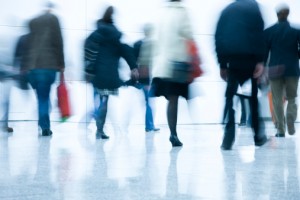New research by Ahreum Maeng, an assistant professor in the University of Kansas School of Business, found that socially-crowded environments lead consumers to be more conservative. Specifically, Maeng found that consumers in crowded settings prefer safety-oriented options and are more receptive to prevention-framed messages than promotional messages – for example, preferring a toothpaste offering cavity protection over a toothpaste promising a whiter smile.
 The research also indicates that consumers in crowded settings might be less willing to make risky investments.
“Consumers in crowded environments get conservative and safety-focused,” she said. “We believe this is because people in socially-crowded settings activate an avoidance system that results in a more prevention-focused mind-set. This, in turn, makes socially-crowded individuals more likely to choose options that provide prevention-focused benefits.”
The research also indicates that consumers in crowded settings might be less willing to make risky investments.
“Consumers in crowded environments get conservative and safety-focused,” she said. “We believe this is because people in socially-crowded settings activate an avoidance system that results in a more prevention-focused mind-set. This, in turn, makes socially-crowded individuals more likely to choose options that provide prevention-focused benefits.”
Additionally, the research indicates that the impact of crowd size is influenced by whether the consumer considers the crowd an “in-group” or “out-group.” Specifically, out-group crowds – people the consumer doesn’t identify as peers – lead to increased conservatism and a greater focus on safety.
Maeng describes her research in an article titled “Conservative when crowded: Social crowding and consumer choice,” which is forthcoming in the Journal of Marketing Research. The article was co-authored by Robin J. Tanner at the University of Wisconsin-Madison and Dilip Soman at the University of Toronto.
The research comprised six experiments, which collectively exposed participants to crowded or uncrowded settings, then had them complete tasks or indicate preferences for messages, products and behaviors. One study had participants complete a questionnaire measuring their preference for prevention-themed concepts (like “avoiding enemies”) versus promotion-themed concepts (like “making friends”). Another experiment asked participants to do a word-search task for safety-related words (like “insurance” or “helmet”) and neutral words (like “coffee”). Yet another experiment gave participants a $10 gift card and asked them to make a series of investment decisions based on different scenarios.
Collectively, the experiments demonstrated that individuals in crowded settings were more conservative and less willing to gamble. And those impacts were moderated by whether participants were surrounded by in- or out-group members.
Maeng’s research would seem to have important implications for various audiences, including consumers, who could use the information to better plan the time and location of their shopping in an effort to better control their decisions.
Of course, perhaps the most obvious beneficiary of Maeng’s research would be store managers and retail marketers, who could use the findings to drive decisions on product placement, marketing and advertising. “For example, our findings indicate a store would benefit by selling and marketing products differently on a crowded Saturday during the holidays versus a Tuesday morning in August,” she said. “And even within the same day, stores might consider changing their signage or product placement to account for different levels of crowding.”
In another example, a political candidate might use a safety-themed message at a crowded rally – “I can protect you from terrorism” – versus a promotional message on a postcard mailed to people’s homes. “We believe our findings could have far-reaching implications and help inform not only individual consumers and marketing professionals but policymakers and citizens in any setting that experiences various levels of crowdedness,” Maeng said.
